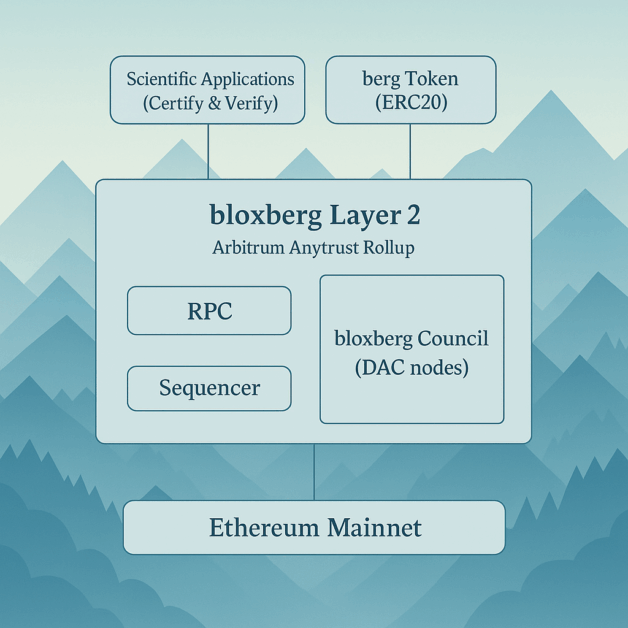Blockchain
We scale scientific trust – through Web3 infrastructure built to last.
In 2019, bloxberg 1.0 was initiated by the Max Planck Digital Library and launched as a public-permissioned Layer 1 blockchain operated by a global consortium of leading research institutions. Built on a Proof-of-Authority consensus model, it was designed to provide a trustworthy and transparent digital foundation for science — independent, sustainable, and openly accessible. Unlike anonymous mining networks, all validator nodes were and still are operated by publicly listed scientific organizations, ensuring full transparency and reputational accountability.
Today, bloxberg is preparing for its next phase: a transition towards a scalable Web3 architecture powered by Ethereum Layer 2 technologies. While Ethereum Layer 1 (Mainnet) serves as the highly secure base layer for anchoring transactions, Layer 2 solutions — such as Arbitrum AnyTrust Rollup — are being evaluated to enable faster processing, lower fees, and greater scalability without compromising on trust or security.
In this future model, the bloxberg Council takes on a central role. Its members — trusted research institutions and science-driven organizations — will operate Data Availability Committees (DACs) that capture and verify every transaction before submitting it to the rollup and finalizing it on Ethereum Layer 1. This architecture ensures that scientific organizations retain full control over data availability and validation, while benefiting from the performance and security guarantees of Ethereum’s decentralized backbone.
Importantly, bloxberg remains a green and resource-efficient blockchain: even in its new architecture, it consumes only a fraction of the energy required by traditional Proof-of-Work systems.
In short: bloxberg combines scientific trust and transparency with modern scalability and decentralization — bringing together the best of both worlds.
bloxberg’s Future Architecture on Ethereum Layer 2
A trust-preserving rollup design with DAC nodes, scientific applications, and Ethereum anchoring.

This simplified architecture illustrates bloxberg’s planned Layer 2 setup using Arbitrum AnyTrust Rollup. Scientific institutions — via the bloxberg Council — operate DAC nodes that validate and preserve transaction data before anchoring it to Ethereum Mainnet. The infrastructure connects directly to scientific applications and enables token-based services — combining performance with transparency and academic control.
Mission
We are building the infrastructure that science deserves.
bloxberg’s mission is to operate a science-driven, publicly accessible blockchain infrastructure that empowers researchers, institutions, science-focused companies, and society to certify, share, and protect knowledge — with transparency, trust, and autonomy. As the world’s first and only global blockchain network run exclusively by research institutions and science-driven organizations, bloxberg offers a verifiable alternative to anonymous blockchain systems: every full ledger node is operated by a publicly listed scientific entity — bringing clarity, credibility, and long-term accountability to the infrastructure.
Since 2019, bloxberg stands for scientific integrity on the blockchain. Originally initiated by the Max Planck Digital Library and a global consortium of research institutions, it was designed to offer a robust and transparent digital foundation for science. At that time, no existing system met the specific needs of research institutions. Public blockchains were volatile, expensive to use, and driven by anonymous mining — a model fundamentally at odds with the principles of transparency, accountability, and sustainability that science relies on. There was no viable way to timestamp hundreds of terabytes of research data — from high-resolution microscopy to genomic pipelines — without incurring unpredictable costs or violating procurement policies. For many institutions, it was simply unthinkable to purchase volatile crypto assets with public funding. That’s why bloxberg was created: a global, science-owned blockchain infrastructure with validator nodes run exclusively by publicly listed research institutions. Built on Proof-of-Authority, it offered fast, secure, and resource-efficient consensus — tailored for scientific integrity, not speculation.
Today, these core ideas still hold. But technology has evolved. Running and maintaining a Layer 1 blockchain has become increasingly complex and expensive — while Ethereum has matured into a trusted foundation even within the scientific world.
That’s why bloxberg is now evolving into a next-generation infrastructure that combines scientific governance with modern Web3 technologies. Through new coordination models like Data Availability Committees and Ethereum Layer 2 scalability, bloxberg will uphold its mission — while preparing science for a decentralized future. By enabling open certification and decentralized digital services, bloxberg supports scientific sovereignty and strengthens the foundations of trustworthy, independent research in the digital age.
Since its inception, bloxberg has included a native token – the berg – as a technical component of the network.
Looking ahead, options for responsible monetization and token-based governance are being explored to strengthen long-term sustainability, reward contribution, and fund innovation within the network – always aligned with bloxberg’s mission to serve science and the public good.
Council
We keep bloxberg’s core in scientific hands.
The bloxberg Council brings together leading institutions to safeguard the network’s core processes and uphold scientific sovereignty. From the very beginning, bloxberg has relied on a global alliance of trusted scientific organizations. In its original Layer 1 design, each institution operated a validator node under a Proof-of-Authority consensus model — ensuring reputational integrity, transparency, and a minimal environmental footprint.
That foundation remains. As bloxberg evolves toward next-generation Layer 2 infrastructure, Council members will operate Data Availability Committees (DACs): a novel coordination model designed to ensure all transaction data is reviewed, preserved, and made accessible by the scientific community before it is submitted to the rollup and finalized on Ethereum Layer 1.
Only Council members are permitted to operate full ledger nodes, ensuring that critical infrastructure and data control remain fully under scientific stewardship.
Membership is open to research institutions and science-driven organizations, with new members admitted through transparent on-chain voting.
Why become a Council Member?
By operating a DAC node, institutions …
-
-
join a global community of research institutions, science-focused companies, and DAOs driving decentralized innovation in science.
-
receive native network tokens for processing transactions — with future potential for monetary value or governance utility.
-
gain early access and influence over the development of blockchain infrastructure tailored to scientific needs.
-
increase voting power through active participation in on-chain proposals.
-
demonstrate leadership in building decentralized and autonomous scientific services.
-
enhance institutional visibility as a trusted validator within a publicly transparent and research-driven ecosystem.
-
operate infrastructure sustainably – with minimal cost, no mining, and a low energy footprint.
-
provide local access for affiliated scientists and developers via institutional bootnodes or APIs.
-
contribute to and benefit from scientific dApps – including timestamping, verification, and future use cases.
-
The bloxberg Council thus continues to serve as the backbone of the network’s integrity – combining academic credibility with modern infrastructure. It safeguards bloxberg’s mission while enabling decentralization, performance, and long-term resilience.
Are you a research institution, a DAO, or a science-focused company interested in joining the bloxberg Council and operating a DAC node?
→ Get in touch – we’d love to hear from you.
Genesis
bloxberg originated as a decentralized blockchain network to ensure the secure and verifiable time-stamping of research data. Scientific integrity depends on the ability to prove the authenticity and existence of data at a given time.
Recognizing the lack of an existing solution that met the specific needs of the scientific community — such as trust, continuity, performance, and independence from commercial interests — the Max Planck Digital Library (MPDL) took initiative. What began as a search for a timestamping service for researchers within the Max Planck Society quickly evolved into something much bigger.
In early 2019, the Max Planck Society brought together eleven research organizations from ten countries to co-found what would become the world’s first decentralized blockchain infrastructure built for science, by scientists. Each of these institutions shared a belief in the transformative potential of blockchain for research – not for speculation, but for verifiability, reputation, and scientific sovereignty.
The story goes that after three days of intense, controversial, and constructive discussion — snowed in at Schloss Ringberg in the Bavarian Alps — the founders passed the bloxberg Whitepaper 1.0, defining both the technical specifications and the initial governance model of the network. This marked the official genesis of the bloxberg blockchain.
Later that year, bloxberg was officially recognized as a flagship project in the German Federal Government’s National Blockchain Strategy. The project was also invited to the Federal Round Table on Blockchain in Science & Research, representing the scientific perspective in shaping national infrastructure policy.
